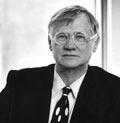
Nicholas Grimshaw: In my lecture entitled “Embedded Intelligence,” I will talk about what I see as the “collective memory” of my architectural practice. It starts way back in the 1870s with my great-grandfather, who built dams on the River Nile in Egypt. I also will talk about my other partners and their relatives, who helped to build the Balkan Railway, barges on the River Thames, and were involved in rocket technology and that of racing cars. Recent projects also will be discussed, such as the Waterloo Eurostar Terminal, Southern Cross Station in Australia, the Frankfurt Exhibition Hall, the Fulton Street Transit Center and, in particular, the Eden Project. I’ll end with some thoughts about the use of new materials and how it might be possible for future buildings to grow their own skins.
What is the biggest challenge facing architects today?
Buildings will now have to be sustainable and energy-efficient by default. The challenge for architects is to make this manifest in their work, so that people again feel that architecture is about substance rather than style.
What are you working on now?
Our eco-rain forest project in Iowa is now getting underway with a $10 million donation from Maxon Holdings. We are also working on the Miami Science Museum, which we hope will be a demonstration project for sustainability. We have just finished the railway station for high-speed trains at Biljmer in Amsterdam and are excited to begin work on the Pulkovo Airport in St. Petersburg, which we have just won through a design competition.







Post a comment to this article
Report Abusive Comment